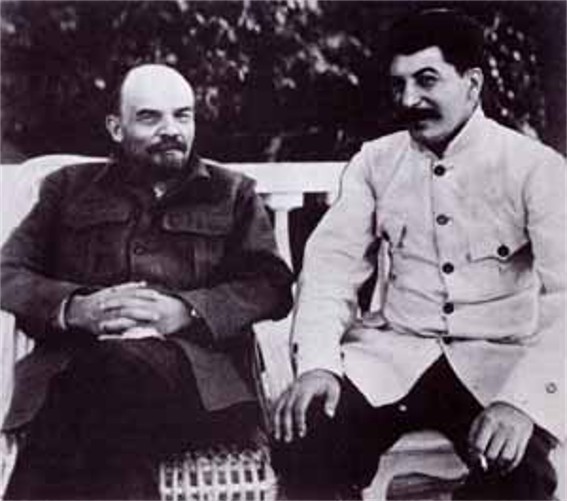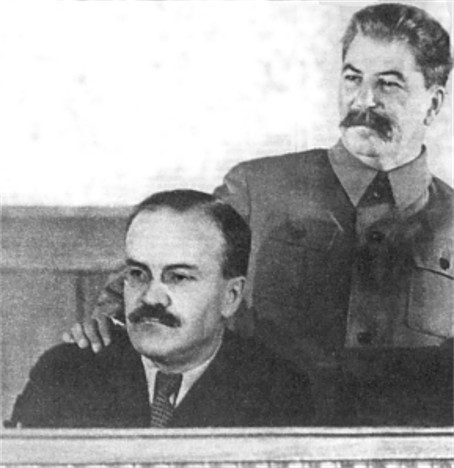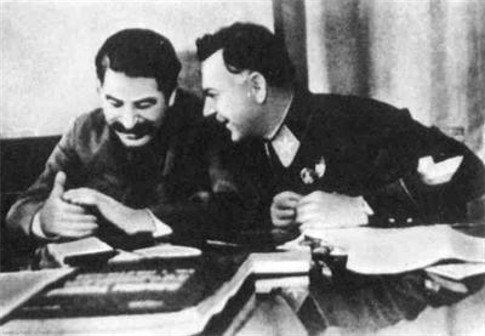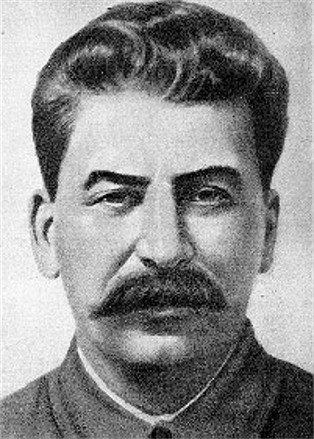Stalin, Joseph
Stalin, Joseph (real name: Yosif Dzhugashvili), b 21 December 1879 in Gori, Georgia, d 5 March 1953 in Moscow. (Photo: Joseph Stalin.) Soviet political leader, first secretary of the Communist Party of the Soviet Union, and absolute dictator of the USSR.
Stalin first emerged as a specialist on the nationality question. In 1914, under Vladimir Lenin's guidance, he wrote Natsional’nyi vopros i marksizm (translated in 1942 as Marxism and the National Question), mostly a criticism of O. Bauer's and K. Renner's interpretation of nationalism, which had gained considerable popularity, especially among Georgian socialists. Because of this work and his Georgian origin he was appointed people's commissar of nationalities in the Bolshevik government (1917–22). In 1919 he also became people's commissar of state control. As commissar of nationalities, in 1920 he opposed the separation of the ‘border’ countries (Ukraine, Georgia, etc), which were important sources of raw materials and food for central Russia. In 1922 he rejected the concept of a union of independent and equal republics and advocated instead the incorporation of the national republics into the Russian Soviet Federated Socialist Republic as autonomous units. Although his idea was rejected, the Russian republic was made the cornerstone of the new union. Stalin relied on the Russian state bureaucracy to convert the Union into a centralized, totalitarian empire (see Nationality policy).
His most important post, however, was the general secretaryship of the Central Committee of the Russian Communist Party (Bolshevik) (RKP[B]), which he assumed in 1922. Although his authority was damaged somewhat by Vladimir Lenin's strong reservations concerning his secretaryship, Stalin used this administrative post to build a firm power base in the Party. By placing his own supporters in key positions he was able to dominate the entire interlocking Party, state, military, and police bureaucracy. After Lenin's death he created a mass personality cult that glorified first Lenin and then himself as an all-powerful and all-knowing leader. One by one he expelled his allies and potential rivals—Leon Trotsky, Grigorii Zinovev, L. Kamenev, A. Rykov, and N. Bukharin—from the Party and then destroyed them. In the late 1920s he announced the policy of ‘socialism in one country,’ whereby he abandoned the New Economic Policy and embarked on a program of rapid industrialization and collectivization, which was enforced by means of widespread terror. Millions of Ukrainian peasants were starved to death during the Famine-Genocide of 1932–3, millions of people were imprisoned in concentration camps, and hundreds of thousands were executed by the secret police. Repeated purges of the Party and government removed any possible source of opposition to his power. A favorite tactic was the show trials, such as those of 1936–8, in which former Bolshevik leaders confessed to treason and implicated many others in their crimes. Almost half of the Party membership was destroyed, and 139 members of the Central Committee were executed. Of 1,966 delegates at the 17th Party Congress in 1934, 1,108 had been arrested by 1939. In the armed forces Stalin organized a major purge that destroyed most of the experienced senior officers on the eve of the Second World War.
In foreign affairs Stalin pursued an expansionist policy based, for a time, on an alliance with Adolf Hitler. He occupied Western Ukraine and the Baltic states, Bessarabia, and Bukovyna (see Molotov-Ribbentrop Pact). Stalin failed to anticipate the German attack on the USSR in 1941, and the Soviets suffered heavy losses in the early stages of the war. At first many Soviet troops, including Ukrainians, had no desire to fight for the Stalinist regime and surrendered en masse. Later, taking advantage of the abominable treatment of the Soviet prisoners of war by the Nazis and of the discontent among the nations subjugated by the Nazis, and playing up patriotism, Stalin succeeded in rallying his subjects and, assisted by the Allies, in emerging as a victor from the war. In the postwar settlement he extended Soviet influence to large new territories in Eastern Europe and the Far East and eventually turned them into Communist-ruled satellite states.
After the war Stalin encouraged the growth of Great Russian nationalism and discriminated against the other nationalities of the USSR. Some of the smaller nations, such as the Volga Germans (see Volga German ASSR), the Crimean Tatars, and the Chechens, were subjected to genocide for their alleged collaboration with the Germans. According to Nikita Khrushchev the Ukrainians were saved from mass deportation only by their large numbers. In 1939–41 and again after the war Stalin Sovietized newly acquired Western Ukraine by deporting hundreds of thousands of people and destroying much of the intelligentsia. At the same time Andrei Zhdanov imposed rigid control on Soviet cultural and intellectual life.
Stalin concentrated all political power in his own hands. From 1941 he was head of state, commissar of defence, and supreme commander of the armed forces (assuming the title of ‘Generalissimos’ in 1945). He built on the traditions of Russian oriental absolutism in creating a totalitarian state cemented together by terror. At the end of his life he began a major assault on the Jews, whom he characterized as ‘rootless cosmopolitans.’ Stalin was not a theoretical thinker, and Stalinism was not a political doctrine; it was a political system of ruthless, unrestricted dictatorship by the Party leader over a demoralized, helpless society.
After Stalin's death Nikita Khrushchev, in his ‘secret speech’ at the 20th Congress of the CPSU (1956), criticized to a degree the ‘cult of personality’ that had arisen around the dictator. This de-Stalinization campaign continued at the subsequent congress in 1961, when it was decided to remove Stalin's embalmed body from Lenin's mausoleum, rename all the places and institutions that had been named in his honor, and dismantle his statues. With Leonid Brezhnev's ascension to power in 1964, however, Stalin was partly rehabilitated, and some measures recalled the excesses of his regime—the personality cult, official Russification, closed trials, and repressions. In its final years the CPSU at last admitted the crimes against humanity committed under Stalin's rule, but it did not accept its responsibility for them.
BIBLIOGRAPHY
Souvarine, B. Stalin: A Critical Survey of Bolshevism (New York 1939)
Kostiuk, H. Stalinist Rule in the Ukraine: A Study of the Decade of Mass Terror, 1929–39 (New York 1960)
Wolfe, B. Three Who Made a Revolution, 4th edn (New York 1964)
Deutscher, I. Stalin: A Political Biography, 2nd edn (London 1967)
Conquest, R. The Great Terror: Stalin's Purge of the Thirties (London–New York 1968)
Tucker, R. Stalin as Revolutionary, 1879–1929 (New York 1973)
Ulam, A. Stalin: The Man and His Era (New York 1973)
Tucker, R. (ed). Stalinism: Essays in Historical Interpretation (New York 1977)
Danylenko, Viktor; Kas’ianov, Heorhii; Kul’chyts’kyi, Stanyslav. Stalinizm na Ukraïni: 20–30-i roky (Edmonton–Kyiv 1991)
Marples, David. Stalinism in Ukraine in the 1940s (New York 1992)
[This article originally appeared in the Encyclopedia of Ukraine, vol. 5 (1993).]



.jpg)

